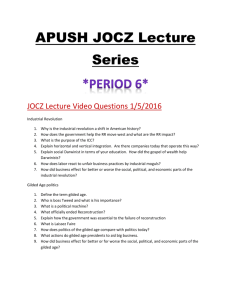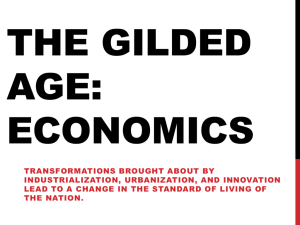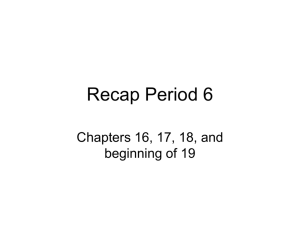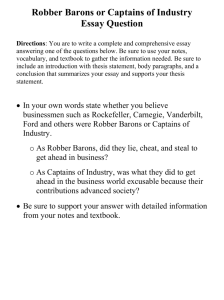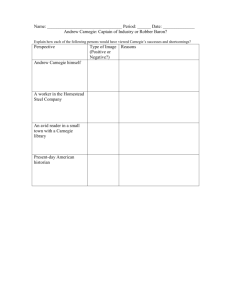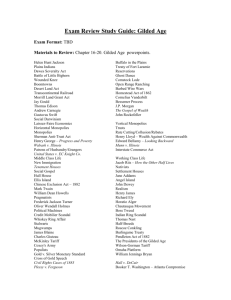Gilded Age
advertisement
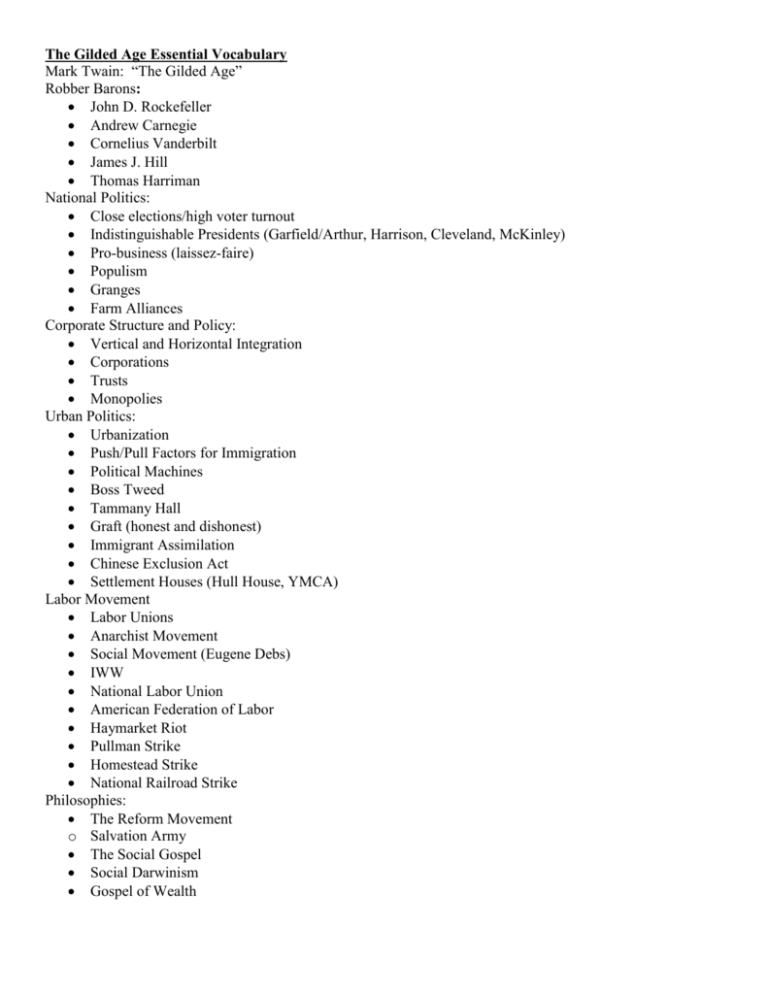
The Gilded Age Essential Vocabulary Mark Twain: “The Gilded Age” Robber Barons: John D. Rockefeller Andrew Carnegie Cornelius Vanderbilt James J. Hill Thomas Harriman National Politics: Close elections/high voter turnout Indistinguishable Presidents (Garfield/Arthur, Harrison, Cleveland, McKinley) Pro-business (laissez-faire) Populism Granges Farm Alliances Corporate Structure and Policy: Vertical and Horizontal Integration Corporations Trusts Monopolies Urban Politics: Urbanization Push/Pull Factors for Immigration Political Machines Boss Tweed Tammany Hall Graft (honest and dishonest) Immigrant Assimilation Chinese Exclusion Act Settlement Houses (Hull House, YMCA) Labor Movement Labor Unions Anarchist Movement Social Movement (Eugene Debs) IWW National Labor Union American Federation of Labor Haymarket Riot Pullman Strike Homestead Strike National Railroad Strike Philosophies: The Reform Movement o Salvation Army The Social Gospel Social Darwinism Gospel of Wealth Legislation: Sherman Antitrust Act Interstate Commerce Act Essential Questions: 1. Does a pro-business government serve the needs of all Americans? 2. In this era of haves and have-nots, assume the identity of one of these players: Andrew Carnegie, Henry Clay Frick, the Pinkertons, a Homestead striker, or President Harrison. Defend your player’s position on the Homestead strike. 3. Is immigration good for America? Essential Skills and/or concepts: The student will be able to develop and use essential core vocabulary specific to the Gilded Age unit. The student will be able to analyze primary resources. The student will be able to interpret and apply essential core historical concepts (Cause and Effect, Pros and Cons, Historical Relevancy). The student will be able to compose effective essays utilizing theses and specific support statements. Phase 1: Formative Assessments on Lassiez-faire, Robber Barons, Labor Terms check (3 short quizzes): Mark Twain: “The Gilded Age” Robber Barons: John D. Rockefeller Andrew Carnegie Cornelius Vanderbilt James J. Hill Thomas Harriman Pro-business (laissez-faire) Corporate Structure and Policy: Vertical and Horizontal Integration Corporations Trusts Monopolies Labor Movement Labor Unions Anarchist Movement Social Movement (Eugene Debs) IWW National Labor Union American Federation of Labor Haymarket Riot Pullman Strike Homestead Strike National Railroad Strike Opposing Viewpoints T-Bar If big business is good for America, why are we having violent labor strikes? Why can’t workers understand that the Robber Barons have the workers’ best interests at heart? Modern day examples of robber barons (Enron, Sub-prime loan fiasco, Amazon.com, Microsoft, Facebook Remedial Activity: list of ideas, people, etc-- identify as Robber Baron or Labor and one significant piece of information to support Enrichment Activity: Predictions--Why did the Robber Barons succeed and why did the labor unions fail? Phase 2: Formative Assessments on Immigration and Urban Politics Segway into this phase with a class discussion of the enrichment activity from phase one. Terms check/Formative Assessment Quiz Urban Politics: Urbanization Push/Pull Factors for Immigration Political Machines Boss Tweed Tammany Hall Graft (honest and dishonest) Immigrant Assimilation Chinese Exclusion Act Settlement Houses (Hull House, YMCA) Activities Map/Characteristics chart comparing “old immigrants” to “new immigrants” Compare push/pull factors of internal immigrants with external immigrants Tammany Hall reflects the mutual interdependence of immigrants and the political machine Solutions to immigrant problem (settlements houses, nativism/exclusion) Remedial Activity Conceptual pictures matching with word bank Enrichment Activity Examples of nativism (past, present, future)—what are the underlying causes of it? Phase 3: Formative Assessments on National Politics and the philosophies of the Gilded Age National Politics: Close elections/high voter turnout Indistinguishable Presidents (Garfield/Arthur, Harrison, Cleveland, McKinley) Pro-business (laissez-faire) Populism Granges Farm Alliances Philosophies: The Reform Movement Salvation Army The Social Gospel Social Darwinism Gospel of Wealth Legislation: Sherman Antitrust Act Interstate Commerce Act Activities Differentiate between the Social Gospel, Social Darwinism, the Gospel of Wealth, and the Salvation Army (Whose philosophy is it? What is the rationale behind it? What was its impact on American society?) With such high voter turnout, why did so many people feel a need for a third political party? Origins of Populism— National Party— Why was it short lived? Congressional legislation to appease the Populists What were its lasting impacts? Remedial Word association with the different reform movements Connections between philosophies and national politics Enrichment Which philosophies are followed today? Support with examples. Other post-Gilded Age third party movements 3rd Parties: 1912, 1968, 1992, 2000
